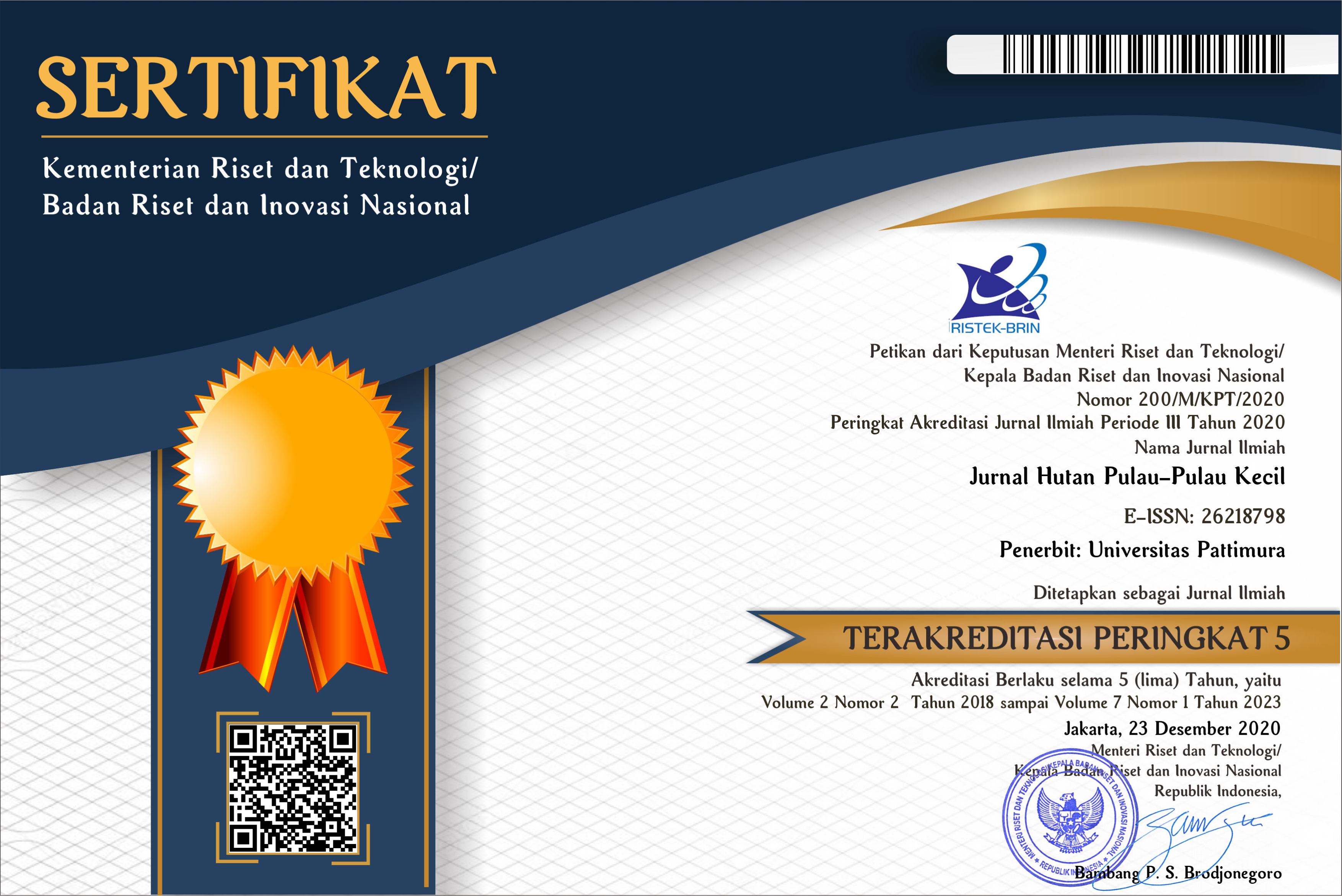KEBERADAAN DAN POTENSI GAYAM (Inocarpus edulis) SEBAGAI POHON PENGHASIL PANGAN ALTERNATIF DI KABUPATEN SERAM BAGIAN BARAT PROVINSI MALUKU
Abstract
Gayam is one species of forest tree that by the community is known as one food source, but the existence of gayam increasingly diminished for that required research to know the existence of gayam through its spreading in nature and also need to know the utilization of gayam as a source of food that has been done by community for this. The purpose of this research was to determine the existence and potential of Gayam as an alternative food and to explore information above Gayam utilization in the community. Data collection in the field took place in Negeri Murnaten Subdistrict of Taniwel, Negeri Hatusua Subdistrict of Kairatu and Negeri Honitetu Subdistrict of Inamosol, West Part Seram District. Gayam's existence data were obtained from vegetation analysis by using a striped line method, while gayam utilization as alternative food was obtained through interview result. Based on the results of this study: Gayam grows and spreads naturally in the Land of Hatusua and Negeri Murnaten on Inceptisol soil type with alluvium parent material and altitude of place less than 500 m asl. Gayam that grows in the Negeri Hatusua and Murnaten have a sparse attendance at all growth levels and have a low IVI. Utilization of gayam as food by the community that is by eating fruit that has been boiled and made gayam chips.
Downloads
References
Harmoni, A. 2014. Manajemen Sumber Daya Hutan. Universitas Gunadarma. Jakarta. http://ati.staff.gunadarma.ac.id/Downloads/files/36125/Sumber+Daya+Hutan.pdf. Download : 10 Maret 2017.
Kusuma, C, 1997. Metode Survey Vegetasi. PT. Penerbit Institut Pertanian Bogor. Bogor.
Kusumaningtyas, R dan I, Chofyan, 2013. Pengelolaan Hutan Dalam Mengatasi Alih Fungsi Lahan Hutan Di Wilayah Kabupaten Subang. Jurnal Perencanaan Wilayah Kota Universitas Islam Bandung. Vol 2, No 13 (2013). Bandung.
Kusumowarno, S. 2014. Percepatan Peningkatan Produksi Dan Produktivitas Padi Di Lahan Rawa Berkelanjutan dan Lestari. Prosiding Seminar Nasional “Inovasi Teknologi Pertanian Spesifik Lokasiâ€. Bogor.
Mueller-Dombois, D. and H. Ellenberg, 1974, Aims and Methods of Vegetation Ecology, John Wiley & Sons, New York.
Nurdin, 2012. Antisipasi Perubahan Iklim Untuk Keberlanjutan Ketahanan Pangan. Jurusan Agroteknologi Fakultas Pertanian Universitas Negeri Gorontalo.
Puspitojati.T, E. Rachman, K.L. Ginoga, 2014. Hutan Tanaman Pangan Realitas, Konsep Dan Pengembangan. Kementrian Kehutanan Badan Penelitian dan Pengembangan kehutanan Pusat Penelitian dan Pengembangan Perubahan Iklim dan Kebijakan. Penerbit : PT Kanisius. Yogyakarta.
Putri, Eka Caesarina Nova, 2013, Inocarpus edulis Forst, Booklet Informasi Benih No. 151, BPTH Maluku Dan Papua.
Setyowati, N dan A. H. Wawo, 2015, Mengungkap Keberadaan dan Potensi Gayam (Inocarpus fagifer) Sebagai Sumber Pangan Alternatif di Sukabumi, Jawa Barat,
Prosiding Seminar Masyarakat Biodiversitas Indonesia Volume 1 Nomor 1 Halam 71-77.




